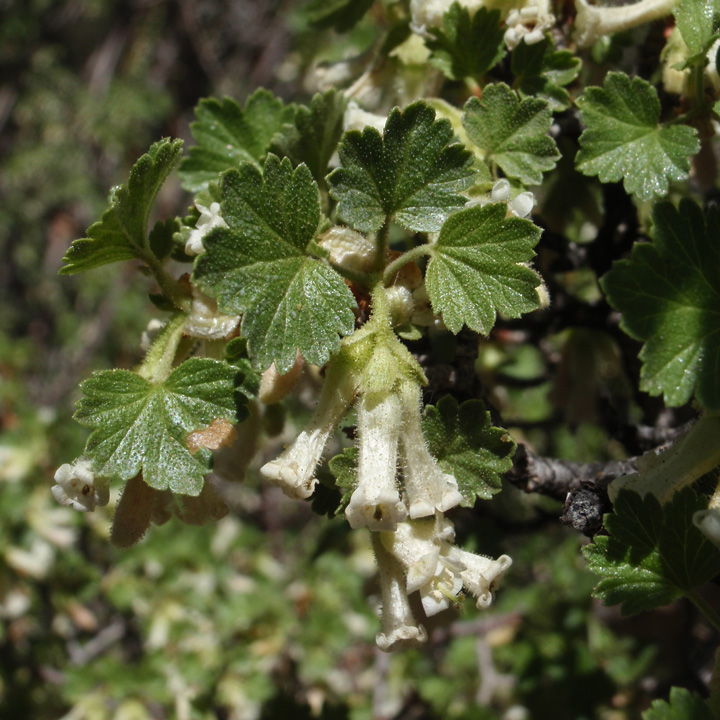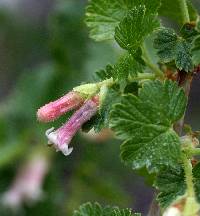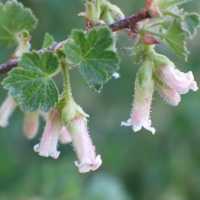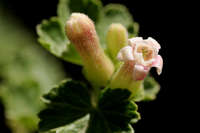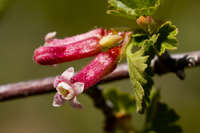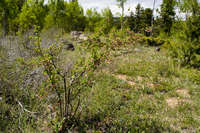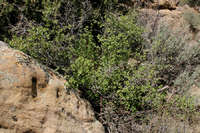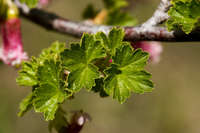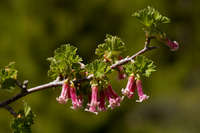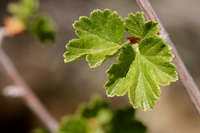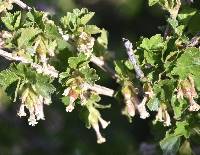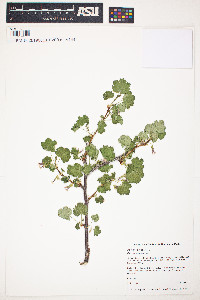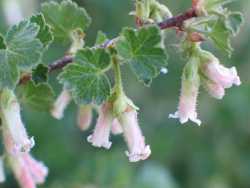|
Family: Grossulariaceae
wax currant
[ Ribes reniforme Nutt., moreRibes viscidulum A.Berger] |
Plants 0.2-2 m. Stems spreading or arching to erect, puberulent, sparsely to copiously stipitate-glandular; spines at nodes absent; prickles on internodes absent. Leaves: petiole (0.3-) 0.6-1.2(-2.8) cm, glabrous or finely to copiously pubescent; blade almost reniform to broadly cuneate-flabellate, 3-5(-7)-lobed, shallowly cleft, (0.5-) 1-2(-4) cm, base cordate to truncate, surfaces glabrous or copiously pubescent, sparsely stipitate-glandular to downy to conspicuously stipitate-glandular and sessile-glandular, particularly noticeable on margins, lobes rounded, margins coarsely crenate-dentate, apex obtuse. Inflorescences pendent, solitary flowers or 2-8(-9)-flowered racemes, 1-3 cm, axis finely pubescent, ± sticky with short-stalked to subsessile glands, flowers tightly clustered at end of peduncle. Pedicels jointed, (0.4-) 1-2.2(-3.4) mm, puberulent; bracts flabellate or ovate to obovate, 3-7(-8.8) mm, pubescent, stipitate-glandular. Flowers: hypanthium white to greenish white with pink tinge, or pinkish white, narrowly tubular, tube widest at base and near throat, 5-9(-9.4) mm, densely hairy and scattered stipitate-glandular abaxially, glabrous adaxially; sepals not overlapping, spreading-recurved, greenish white to white or faintly to strongly pinkish tinged, deltate-ovate, 1-3.2 mm; petals connivent, erect, white to pink, orbiculate or flabellate, not conspicuously revolute or inrolled, 1-2.1 mm; nectary disc not prominent; stamens shorter than petals, (inserted below petals and completely included in hypanthium tube); filaments linear, 0.5-1.6 mm, glabrous; anthers pale cream-yellow to yellow, oval, 0.6-1.2 mm, apex with small, cup-shaped gland; ovary glabrous or hairy or sparsely to densely pubescent; styles connate nearly to stigmas, 7.5-11.5 mm, proximally hairy or glabrous. Berries tasteless, dull to bright red or orange-red, ovoid, 5-12 mm, sparsely glandular to glandular. 2n = 16. Ribes cereum has a notably spicy odor. The bright green style, which becomes brown with age, is striking. FNA 2009, Kearney and Peebles 1969, Martin and Hutchins 1980 Common Name: wax currant Duration: Perennial Nativity: Native Lifeform: Shrub General: Shrubs to 2 m, spreading to erect, stems lightly pubescent, gland-dotted, spines absent. Leaves: Kidney-shaped, 3-5 lobed but shallowly cleft, surfaces smooth to densely pubescent, gland-dotted, especially on the margins, borne on petioles to 1 cm. Flowers: Inflorescences solitary to clustered racemes, pendulous, flowers greenish white to light pink, hypanthium cylindric, 6-8 mm long, narrowly tubular and widening at the base and throat, densely hairy on the outside surface, smooth inside, sepals about 2 mm long, exceeding petals, stamens not exceeding the petals, anthers pale cream to yellow, styles connate, sepals light green to light pink, tips recurved. Fruits: Berries, bright orange to bright red, ovoid, glandular, 5-12 mm, tasteless. Ecology: Found on rocky slopes or cliffs in open forests and shrublands, from 300-13,000 ft (91-3962 m); flowers April-August. Notes: The key to this species is the narrowly tubular flowers with 1-2 mm petals, narrowly tubular hypanthium and 0.5-1 mm anthers. Also, the plant has a notably spicy odor. Ethnobotany: Decoction of bark used as a medicine for gastrointestinal complaints, eye medicine, and tonic. The berries were an important food source for many indigenous peoples. Etymology: Ribes is from the Syrian or Kurdish ribas, which is derived from an old Persian word, while cereus is Latin for waxy. Synonyms: None Editor: LCrumbacher, 2011 |

